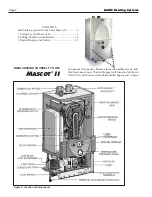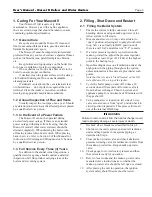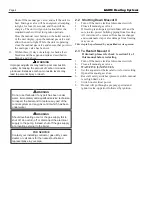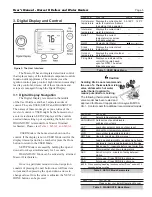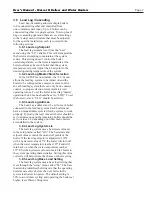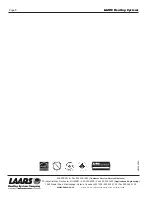
LAARS Heating Systems
Page 6
3.2 Ignition Control- Sequence of Events
1. Call for heat
2. Safety chain check
3. Fan starts.
4. Prepurge timer is started.
5. Pre ignition time of 2 seconds to check the flame
sensor operation and status.
6. Trial for ignition period, 4 seconds. The direct
spark ignition switches to constant spark for three
seconds, during which time the gas valve is open.
For the last second of the ignition period direct
spark is de-energized and the flame sensor checks
for established flame. If flame is sensed the control
enters “Run” to satisfy the demand. If flame is
not established the control enters a retry, starting
from step 2. If flame has not been established in
the appropriate number of retries the control will
lockout with a 109 error code.
7. Call for heat complete
8. Gas valve off
9. Fan and pump over run times active to purge the
system
The sequence is the same for DHW or Central
Heat modes. Upon a call for Central Heat, the 3-way
valve will shift position, allowing boiler water to enter
the building’s heating loop. Only after the value shifts
position will the firing sequence begin.
3.3 Modulation Control
The control uses a PID algorithm to adjust
the firing rate of the boiler as the control point is
approached. The goal of the control is to operate
at a minimum firing rate to match the load on the
appliance. The burner modulates to achieve the setpoint
temperature, away from the actual off point.
3.4 Pump Control
The boiler pump is active anytime there is a call
for heat applied to the control. When there is a central
heat call supplied the system pump relay is active. If
there is a DHW call supplied while the central heat
call is active the system pump turns off. This happens
because of domestic hot water priority, which forces
the control to satisfy the domestic water demand prior
to the hydronic demand. When the last heat demand is
satisfied the boiler pump enters an overrun time.
3.5 High Limit
The control uses a dual thermistor sensor to
monitor the Mascot II’s maximum temperature. The
high limit sensor is installed in the outlet water. A dual
thermistor sensor is used, so that the two temperatures
can be monitored and compared to confirm accuracy.
The control will automatically reduce the firing of the
Mascot II to prevent the high limit from tripping. The
high limit setpoint is not adjustable.
3.6 Stack Temperature
The stack temperature is a dual thermistor sensor
and is limit rated. The control compares each of the
temperature readings to determine accuracy. The stack
sensor is used as a limiting feature to avoid excessive
temperatures in the venting.
3.7 Domestic Hot Water Temperature
The domestic hot water temperature sensor is used
to control DHW temperature. The DHW setpoint can be
adjusted through the USER menu structure.
DHW setpoint is displayed during DHW mode. For
LMH model, an aquastat will be used in lieu of a sensor
to control temperature of an indirect tank.
Caution
Scalding Risk: Laars recommends the use of a
thermostatic mixing valve at domestic hot water
outlet (boiler location) to reduce potential for
scalding.
The following thermostatic mixing valve model has been
tested and approved for Mascot II application: Honeywell
AM100-US-1. Contact Laars for additional recommended
models.


